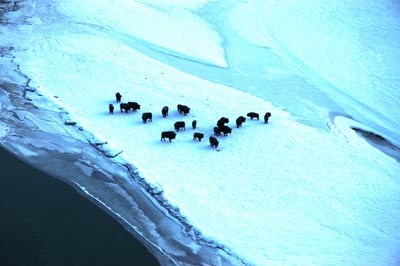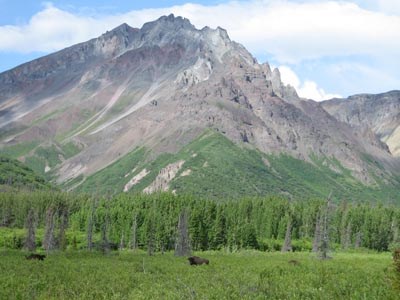Last updated: November 6, 2017
Article
Bison Bellows: Wrangell-St. Elias National Park and Preserve

NPS Photo
In a park that is the size of Switzerland and Yellowstone combined, Wrangell-St. Elias National Park and Preserve in Alaska is the largest National Park in the United States. It is home to nine of the sixteen highest peaks in the United States, the biggest tidewater glacier in North America (Hubbard Glacier), and one of the largest active volcanoes in North America (Mt. Wrangell). With sheer magnitude, this park offers everything imaginable. It is even home to two bison herds that are often considered the most free-ranging herds in the United States: Copper River herd and Chitina River herd.
Bison were reintroduced in Alaska in 1928, when 19 animals from the National Bison Range in Montana were released near the Delta Junction. These 19 animals helped establish the Copper River herd in 1950 and the Chitina River herd in 1962. What is most notable is the first herd was established before Wrangell-St. Elias became a national park in 1980, in fact before Alaska became a state. Today, the herds average between 50-120 individuals. In 2013, the Copper River herd had 156 individuals, the highest number ever recorded.

NPS Photo
Management takes a completely "hands-off" approach, as deep snow and hunter harvests control the herd sizes. "As far as handling, we have no set standard. Harvest goals are established by the Alaska Department of Fish and Game following aerial surveys," says Eric Veach, Acting Superintendent at Wrangell-St. Elias National Park and Preserve. "Because of the unfragmented and remote landscape, the bison herds move around naturally and we rarely intervene." Unlike many other National Parks, Wrangell St.-Elias National Park and Preserve allows hunting. In collaboration with the State of Alaska, the National Park Service manages the wildlife resources in the park. Sport hunting is the only type of hunting that is allowed within the national preserve (not the park) and it must be in accordance with Alaska State Law. However, subsistence hunting by rural, local residents is allowed in both the park and preserve. Subsistence hunting allows Alaskan residents to continue cultural or traditional uses and harvests without excluding them from doing these activities within the park.
The Alaska Department of Fish and Game authorizes a drawing system that determines bison harvests for the year. Management objectives aim to maintain a herd of 50 (Chitina River herd) and 60 (Copper River herd) overwintering individuals. This number roughly translates to about 24 hunter permits distributed each year out of the roughly 1,100 hunters that apply. Although 24 permits are issued, some hunters choose not to use them or are unsuccessful in hunting a bison. Depending on herd sizes however, hunting can be closed for the season if bison numbers are too low. Each year, the Alaska Department of Fish and Game offers two big game governor's tags for bison as well. "These tags can range from $25,000 to $40,000 each!" said Veach. Since 1997, over a quarter of a million dollars in revenues have helped state bison programs. "This money goes to the Alaska Department of Fish and Game that helps them protect wildlife and work on conservation efforts within the State of Alaska," said Veach.
